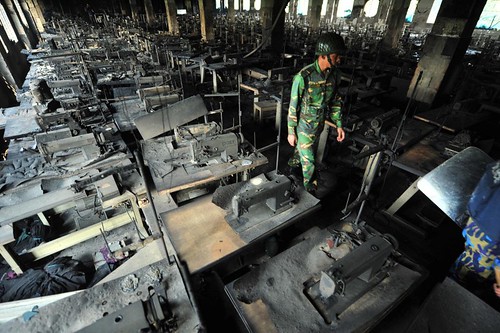Another fire broke out at a garment factory in Dhaka, Bangladesh, two days after a blaze at a separate clothing factory killed at least 121 people.
The fire broke out on the third floor of the 12-story building, which houses four different garment factories. Some of the building’s workers are trapped on the rooftop, firefighters reported.
Al Jazeera reports that some workers had been trapped on the roof by the new fire, but authorities said that although they were still searching the building, they believed most had escaped and there were no reported deaths.
"We don't have any casualties but the firefighters will search the building and see whether anyone has been suffocated," said Nisharul Arif, Dhaka deputy commissioner of police.
About 15,000 Bangladeshi workers protested blocks from the gutted fire Monday, demanding justice for the victims and improved safety. Some 200 factories were closed for the day after the protest erupted in Savar, a suburb of Dhaka, the capital.
Protesters blocked a major highway, and some threw stones at factories and smashed vehicles, but there were no arrests and no clashes with police.
More details emerge on the deadly garment factory fire on Saturday:
Survivor Mohammad Ripu said Monday that he tried to run out of the building when the fire alarm rang but was stopped.
"Managers told us, 'Nothing happened. The fire alarm had just gone out of order. Go back to work,'" Ripu said. "But we quickly understood that there was a fire. As we again ran for the exit point we found it locked from outside, and it was too late."
Ripu said he jumped from a second-floor window and suffered minor injuries.
Another surviving worker, Yeamin, who uses only one name, said fire extinguishers in the factory didn't work, "So these were meant just to impress the buyers or authority."
Labor groups hope that the deadly blaze will prompt changes in safety for Bangladesh's 4,000 garment factories, and they hope the government will "work harder" to punish factories with safety lapses. The owner of the factory in the deadly blaze is Tazreen Fashions Ltd., a subsidiary of the Tuba Group that produced clothing for Wal-Mart, and other retailers:
The Tuba Group is a major Bangladeshi garment exporter whose clients include Wal-Mart, Carrefour and IKEA, according to its website. Its factories export garments to the U.S., Germany, France, Italy and the Netherlands, among other countries. The Tazreen factory, which opened in 2009 and employed about 1,700 people, made polo shirts, fleece jackets and T-shirts.
Tazreen was given a "high risk" safety rating after a May 16, 2011, audit conducted by an "ethical sourcing" assessor for Wal-Mart, according to a document posted on the Tuba Group's website. It did not specify what led to the rating.
Wal-Mart spokesman Kevin Gardner said online documents indicating an orange or "high risk" assessment after the May 2011 inspection and a yellow or "medium risk" report after an inspection in August 2011 appeared to pertain to the factory. The August 2011 letter said Wal-Mart would conduct another inspection within one year.
Gardner said it was not clear if that inspection had been conducted or whether the factory was still making products for Wal-Mart. If a factory is rated "orange" three times in two years, Wal-Mart won't place any orders for one year. The May 2011 report was the first orange rating for the factory.
For Wal-Mart's part:
"Our thoughts are with the families of the victims of this tragedy," the retailer said in a statement. "While we are trying to determine if the factory has a current relationship with Wal-Mart or one of our suppliers, fire safety is a critically important area of Wal-Mart's factory audit program and we have been working across the apparel industry to improve fire safety education and training in Bangladesh."
In its 2012 Global Responsibility report, Wal-Mart said it ceased working with 49 factories in Bangladesh in 2011 because of fire safety issues, and was working with its supplier factories to phase out production from buildings deemed high risk.
As for fire safety, the workers who survived the deadly blaze knew to look for emergency exits, and fire extinguishers, that tragically either didn't exist in their factory or were inoperable. Workers who tried to respond to fire alarms that were working were stopped by management from doing so. What good are "fire safety education and training" in a place where companies have no regard for human life? The only certain way to end these tragic deaths is for retailers who purchase goods from foreign nations to inspect factories themselves that they are considering doing business with, and refuse to purchase from those factories that don't meet the same standards of safety as we expect here in the US.
I know...when pigs fly.












